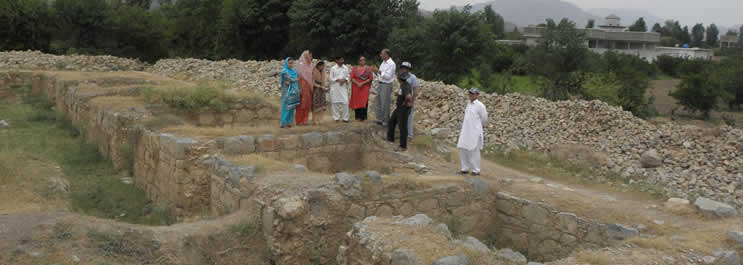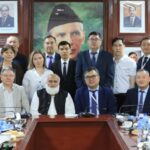New discoveries at Badalpur Buddhist Monastery
Taxila Valley By Muhammad Ashraf Khan, Director Taxila institute of Asian Civilizations
Taxila institute of Asian civilizations Quaid-i-Azam University has started archaeological excavations on the Buddhist monastery of Badalpur with the collaboration of Directorate of Archaeology and museums, Government of Khyber Pakhtoonkhwa under the leadership of Dr. Muhammad Ashraf Khan, Director, Taxila Institute of Asian Civilizations, Quaid-i-Azam University, Islamabad. In this excavation the faculty and students of the Quaid-i-Azam University, Islamabad is also participating. During the current excavation the remains of assembly hall, kitchen, stores and steward rooms have been exposed and a good number of antiquities were discovered during excavation dated 1st century to 4th century CE.
The Badalpur site is situated about 9 km North West Taxila museum and 2 km North-West of Julian village. Alexander Cunningham, the then Director General of Archaeological Survey of India visited this important Buddhist monastery during 1863-64. Natisa Aiyar, Superintendent, Archaeological Survey, Frontier Circle was the first to conduct a limited excavation at the stupa during 1916-17. Further excavations were carried out the site by the federal department of Archaeology and museums from 2005-2009 led by Dr. Muhammad Ashraf Khan, Dr. Arif and Mr. Shakir Ali. During the course of excavations a huge number of antiquities have been discovered. These antiquities include potteries, gold and copper coins, seals and sealings, beads, iron objects and grinding mills. But the most remarkable discovery of the excavations is the discovery of a Mathura sculpture of the Buddha made from reddish sand stone. The sculpture depicts a Buddha seated on a throne with a cross legged, both soles of the feet having dharmachakra symbols. The right hand is in abhaya mudra with a wheel of law on the palm. pipal tree is engraved at the back of the sculpture. Similar Mathura style sculpture of Buddha was also discovered from the surface of Bhari Dheri site in Taxila valley. Due to this unique discovery it is very clear that the Mathura images of Buddha from these sites were originated from the soil of Mathura and were presented to these monasteries by some devotees/monks during their pilgrimage to the holly shrine of Taxila in the era of 2nd century CE. Another remarkable discovery is the sculpture of bodhisattva Maitreya and a stupa shaped relic casket in schist stone was also revealed during the past excavation from this monastery.
 PM’s Laptop Scheme’s Provisional List has been shared with Department Focal Person. Check your status, please
PM’s Laptop Scheme’s Provisional List has been shared with Department Focal Person. Check your status, please







